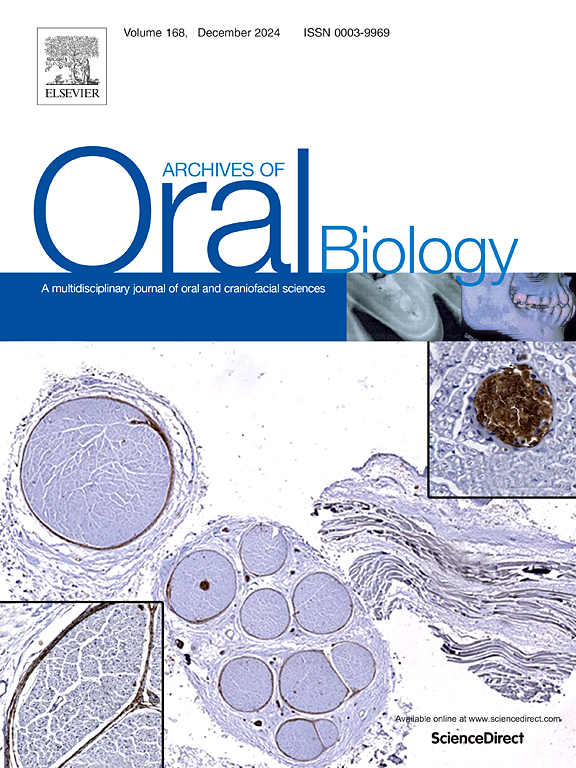截断重组Jagged1与人IgG1 Fc融合激活人牙周韧带细胞Notch靶基因。
IF 2.2
4区 医学
Q2 DENTISTRY, ORAL SURGERY & MEDICINE
引用次数: 0
摘要
目的:Notch配体Jagged1通过与Notch2相互作用诱导成骨标志物、碱性磷酸酶活性和矿物沉积,对人牙周韧带细胞(hpdl)的成骨分化至关重要。然而,它的大尺寸阻碍了生物材料的吸收和分布。本研究旨在确定Jagged1与Notch2相互作用所必需的关键区域,以创建一个保留成骨活性但具有改进的传递特性的截断版本。方法:通过删除c端区域设计Jagged1的截断版本,重点关注n端结构域的重要性。截断和全长Jagged1均与人IgG1 Fc (Jagged1-Fc)融合,并在中国仓鼠卵巢细胞中表达。用real-time PCR分析这些构建体处理的hpdl的Notch靶基因表达情况。用茜素红S染色评价矿物沉积。结果:截断和全长Jagged1-Fc均增加了Notch靶基因Hes1、Hey1和ALP在hpdl中的表达,表明Notch信号成功激活。然而,只有全长Jagged1-Fc增强了矿物沉积,而截断版本则没有。结论:全长Jagged1-Fc对于hpdl的矿物沉积和完整的成骨分化是必需的。截断的版本,虽然能够激活Notch信号,但在促进矿化方面是无效的,强调了整个蛋白质在骨再生临床应用中的重要性。本文章由计算机程序翻译,如有差异,请以英文原文为准。
Truncated recombinant Jagged1 fused with human IgG1 Fc activates Notch target genes in human periodontal ligament cells
Objective
Jagged1, a Notch ligand, is essential for osteogenic differentiation in human periodontal ligament cells (hPDLs) by interacting with Notch2 to induce osteogenic markers, alkaline phosphatase activity, and mineral deposition. However, its large size hampers absorption and distribution of biomaterials. This study aimed to identify the critical region of Jagged1 necessary for its interaction with Notch2 to create a truncated version that retains osteogenic activity but with improved delivery characteristics.
Methods
Truncated versions of Jagged1 were designed by deleting C-terminal regions, focusing on the importance of the N-terminal domain. Both truncated and full-length Jagged1 were fused with human IgG1 Fc (Jagged1-Fc) and expressed in Chinese hamster ovary cells. hPDLs treated with these constructs were analyzed for Notch target gene expression using real-time PCR. Mineral deposition was assessed using alizarin red S staining.
Results
Both truncated and full-length Jagged1-Fc increased the expression of Notch target genes (Hes1, Hey1, and ALP) in hPDLs, indicating successful activation of Notch signaling. However, only the full-length Jagged1-Fc enhanced mineral deposition, while the truncated version did not.
Conclusions
Full-length Jagged1-Fc is required for mineral deposition and complete osteogenic differentiation in hPDLs. The truncated versions, while capable of activating Notch signaling, are ineffective in promoting mineralization, underscoring the importance of the entire protein for clinical applications in bone regeneration.
求助全文
通过发布文献求助,成功后即可免费获取论文全文。
去求助
来源期刊

Archives of oral biology
医学-牙科与口腔外科
CiteScore
5.10
自引率
3.30%
发文量
177
审稿时长
26 days
期刊介绍:
Archives of Oral Biology is an international journal which aims to publish papers of the highest scientific quality in the oral and craniofacial sciences. The journal is particularly interested in research which advances knowledge in the mechanisms of craniofacial development and disease, including:
Cell and molecular biology
Molecular genetics
Immunology
Pathogenesis
Cellular microbiology
Embryology
Syndromology
Forensic dentistry
 求助内容:
求助内容: 应助结果提醒方式:
应助结果提醒方式:


